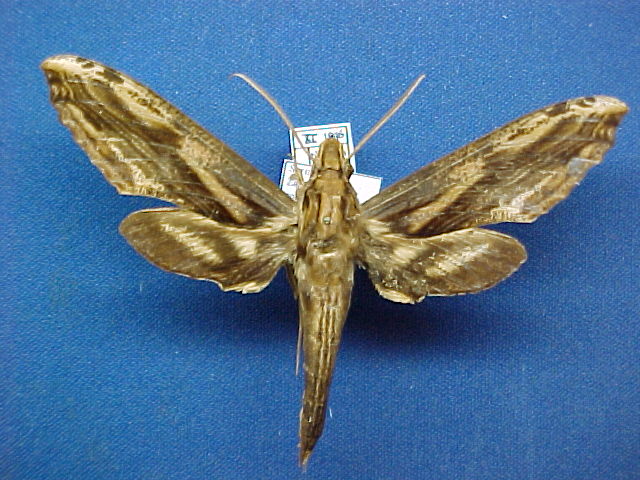Xylophanes colinae
Xylophanes colinae
zail-AH-fan-eesmm
kah-LEEN-aye
Haxaire, 1994

Xylophanes colinae courtesy of John Vriesi.
This site has been created by
Bill Oehlke at oehlkew@islandtelecom.com
Comments, suggestions and/or additional information are welcomed by Bill.
TAXONOMY:
Family: Sphingidae, Latreille, 1802
Subfamily: Macroglossinae, Harris, 1839
Tribe: Macroglossini, Harris, 1839
Genus: Xylophanes Hubner [1819] ...........
Species: colinae Haxaire, 1994
|
MIDI MUSIC
.....It's a Wonderful World.....
copyright C. Odenkirk
ON.OFF
<bgsound src="world.mid" LOOP=FOREVER>
|
DISTRIBUTION:
Xylophanes colinae (approximate wingspan: males: 68mm; females: 89mm)
flies in
Venezuela (specimen type locality);
French Guiana: Montagnes de la Trinité; Kaw; Godebert-Maroni;
Ecuador: Zamora; and
probably in Suriname and Guyana.
The abdominal lines are like those of ceratomioides but the outer lines are more continuous from segment to segment
This species is intermediate between ceratomioides and guiananesis, but it is smaller, with more rounded wings and an even more strongly scalloped
outer forewing margin than guianensis.
The most distal antemedian line and most basal postmedian line meet along the inner margin as in guiananesis.
The pale brown excavated area on outer margin of postmedian band as in ceratomioides but narrower, appearing smaller.
The hindwing subbasal and median bands are orange-brown; off-white in ceratomioides and guianensis.
FLIGHT TIMES:
Xylophanes colinae adults probably brood continuously. Specimens have been taken in French Guiana in January and February.
ECLOSION:
Pupae probably wiggle to surface from subterranean chambers just prior to eclosion.
SCENTING AND MATING:Females call in the males with a pheromone released from a gland at the tip of the
abdomen. Males come in to lights very readily, but females are seldom taken in that way.
EGGS, LARVAE, PUPAE:
Larvae probably feed on Psychotria panamensis and Psychotria nervosa
of the Rubiaceae family and on
Pavonia guanacastensisof the Malvaceae family.
Moths emerge approximately one-two months after larvae pupate.
The pronunciation of scientific names is
troublesome for many. The "suggestion" at the top of the page is
merely a suggestion. It is based on commonly
accepted English pronunciation of Greek names and/or some
fairly well accepted "rules" for latinized scientific names.
The suggested pronunciations, on this page and on other pages,
are primarily put forward to assist those who hear with internal
ears as they read.
There are many collectors from different countries whose
intonations and accents would be different.
Jean Marie Cadiou writes, "When I say "Xylophanes" in English I
pronounce it something like "Zailophanees", with the emphasis on the
"o". The French pronounce it differently, something like
"Kzeelophaness" with no emphasis, and the Germans yet in a
different way..."
In Greek myth, Phanes is the golden winged Primordial Being who
was hatched from the shining Cosmic Egg that was the source of the
universe. He personifies light emerging from chaos.
"Xylo" is the Greek word for wood.
The specimen type for the genus
Xylophanes is Xylophanes anubus. Perhaps ? when Hubner
examined this species, the yellow-orange and brown tones of the
forewings suggested wings of wood.
The species name "colinae" ...
Use your browser "Back" button to return to the previous page.
Goto Main Sphingidae Index
Goto Macroglossini Tribe
Goto Central American Indices
Goto Carribean Islands
Goto South American Indices
Goto U.S.A. tables
